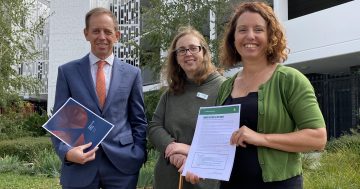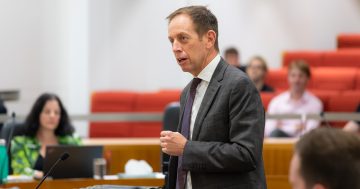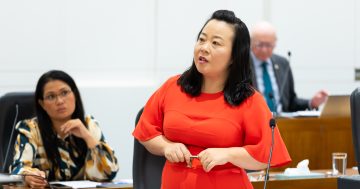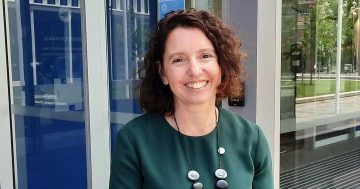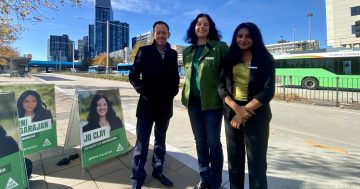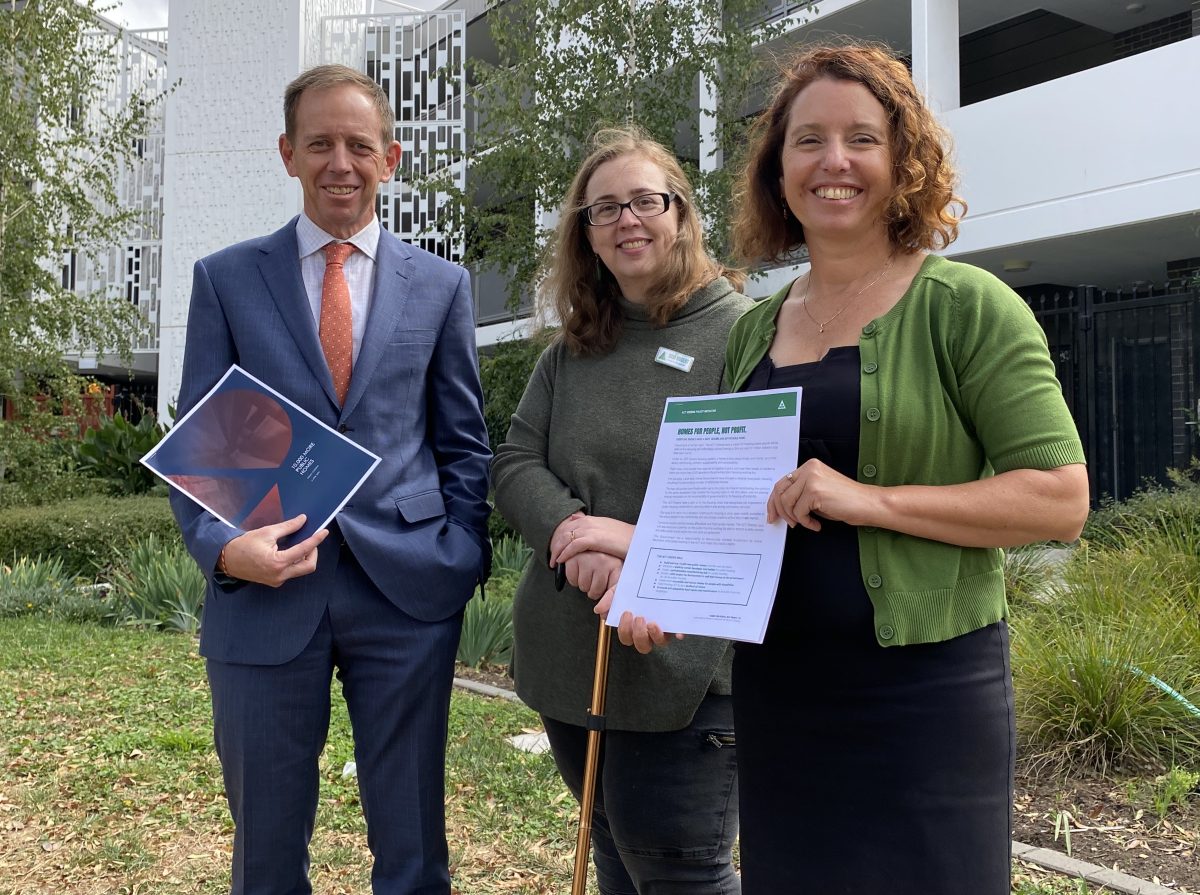
ACT Greens leader Shane Rattenbury, Brindabella candidate Sam Nugent and deputy leader Rebecca Vassarotti have announced the party’s ambitious plan to deliver 10,000 public housing dwellings by 2035. Photo: Claire Fenwicke.
The ACT Greens have pledged to build 10,000 public homes in 10 years if they gain power at the upcoming election.
The party has promised to build and buy the homes, along with introducing several other initiatives to accelerate delivery and provide more certainty that public homes will be built.
“We have been spun the line for far too long that housing is a great investment for everyone but governments,” ACT Greens deputy leader Rebecca Vassarotti said.
“Make no mistake: this is a bold and transformative policy, but it is also eminently achievable and affordable.”
The party engaged Purdon Strategy and Economics to cost the plan, which is based on the conditions that the Territory would have an infill policy of 80 per cent (rather than the current 70 per cent), a policy to increase development rights in residential zoned land, and for the Suburban Land Agency to lower the price of land from ACT Government releases by 50 per cent when sold to Housing ACT.
The capital cost of 10,000 homes by 2035 has been estimated at $5 billion to $9.5 billion over the 10-year period, broken down into capital injections of $5.9 billion, appropriations to support capital injections of $10.1 million, and public debt interest of $1.7 billion. Revenue from land sales would also be $137 million lower.
The program would be staged to deliver about 500 homes each year for the first two years before ramping up, equating to $2.2 billion over a term of government, or $280 million each year.
Ms Vassarotti said the costings were “conservative” and achievable.
“In the context of an $8 billion budget each year, that is a fairly modest cost, particularly when we look at what we’re getting for that spend,” she said.
“This is about an infrastructure project … governments borrow [money] for infrastructure all the time, that doesn’t mean that we’re not able to provide services.”
The ACT Greens would also look at other ways to raise the money or save costs elsewhere.
Leader Shane Rattenbury said this was an “essential spend” to correct a “significant market failure” that had occurred.
“We will pay for it through a mixture of Federal Government co-contribution, that we’ll be fiercely seeking, taking the necessary borrowings to be able to fund it, and resourcing it over time through the ordinary budget processes,” he said.
“This program [also] has the potential to bring significant savings back to government through reduced spending on a range of social services in corrections, health, and other areas that are [putting] significant pressures on the budget at the moment.”
Ms Vassarotti was confident it could all be paid for even if the Commonwealth didn’t come to the table.
“We think that the assumptions that are built into the costings are very achievable and we know that no matter what happens, there will be a significant infill program that’s happening over this period of time,” she said.
“We will work with all of the levers we have to ensure Housing ACT actually has a fair go and we’re able to create a situation where we’re not creating a false economy when Housing ACT needs to purchase land at a market rate.”
Another part of the policy is to establish a publicly owned developer and builder for public housing.
Ms Vassarotti said this would provide more certainty not only for building public houses but also for addressing the maintenance backlog and getting the government better value for money.
“A government developer and builder means, one, it won’t be profit that is the underlying desire [to build these homes], it will actually be providing homes to people, and [two], we’ll be able to take opportunities in terms of bulk purchases and bringing skills and trades together,” she said.
A prefabrication manufacturing hub would also be developed with a promise to deliver 280 prefabricated public housing dwellings by 2035.
Adaptive re-use of commercial buildings would be investigated to deliver 70 dwellings to the Housing ACT portfolio by 2028-29.
The importance of this policy was highlighted by the personal experience of ACT Greens Brindabella candidate Sam Nugent.
She became homeless following a “violent” divorce and ended up sleeping in her car or under her office desk despite having a decent salary working in the mental health space.
Ms Nugent said she’d never considered public housing an option as she knew people were in situations worse than hers, knew the stock wasn’t there, and was ashamed to ask for help.
“Having a government go back to how it used to be and making public and affordable housing a landlord of choice, that gives you so much more options to start again when you have to start again – whether you want to or not,” she said.
“I wish I’d had that when I went through homelessness … I wish I could have had a different option to start again.”
As for the other parties heading into the election? Ms Vassarotti issued a challenge: “Demonstrate how you are going to deal with this issue, which is probably one of the biggest issues in our community and across Australia.”












